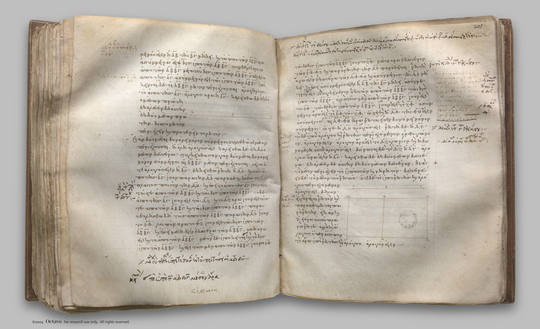index prev next | digilib folio 209

If two medial straight lines commensurable in square only and containing a medial rectangle be added together, the whole is irrational; and let it be called a second bimedial straight line.
| Ἐὰν δύο μέσαι δυνάμει μόνον σύμμετροι συντεθῶσι μέσον περιέχουσαι, ἡ ὅλη ἄλογός ἐστιν, καλείσθω δὲ ἐκ δύο μέσων δευτέρα. Συγκείσθωσαν γὰρ δύο μέσαι δυνάμει μόνον σύμμετροι αἱ ΑΒ, ΒΓ μέσον περιέχουσαι: λέγω, ὅτι ἄλογός ἐστιν ἡ ΑΓ. Ἐκκείσθω γὰρ ῥητὴ ἡ ΔΕ, καὶ τῷ ἀπὸ τῆς ΑΓ ἴσον παρὰ τὴν ΔΕ παραβεβλήσθω τὸ ΔΖ πλάτος ποιοῦν τὴν ΔΗ. καὶ ἐπεὶ τὸ ἀπὸ τῆς ΑΓ ἴσον ἐστὶ τοῖς τε ἀπὸ τῶν ΑΒ, ΒΓ καὶ τῷ δὶς ὑπὸ τῶν ΑΒ, ΒΓ, παραβεβλήσθω δὴ τοῖς ἀπὸ τῶν ΑΒ, ΒΓ παρὰ τὴν ΔΕ ἴσον τὸ ΕΘ: λοιπὸν ἄρα τὸ ΘΖ ἴσον ἐστὶ τῷ δὶς ὑπὸ τῶν ΑΒ, ΒΓ. καὶ ἐπεὶ μέση ἐστὶν ἑκατέρα τῶν ΑΒ, ΒΓ, μέσα ἄρα ἐστὶ καὶ τὰ ἀπὸ τῶν ΑΒ, ΒΓ. μέσον δὲ ὑπόκειται καὶ τὸ δὶς ὑπὸ τῶν ΑΒ, ΒΓ. καί ἐστι τοῖς μὲν ἀπὸ τῶν ΑΒ, ΒΓ ἴσον τὸ ΕΘ, τῷ δὲ δὶς ὑπὸ τῶν ΑΒ, ΒΓ ἴσον τὸ ΖΘ: μέσον ἄρα ἑκάτερον τῶν ΕΘ, ΘΖ. καὶ παρὰ ῥητὴν τὴν ΔΕ παράκειται: ῥητὴ ἄρα ἐστὶν ἑκατέρα τῶν ΔΘ, ΘΗ καὶ ἀσύμμετρος τῇ ΔΕ μήκει. ἐπεὶ οὖν ἀσύμμετρός ἐστιν ἡ ΑΒ τῇ ΒΓ μήκει, καί ἐστιν ὡς ἡ ΑΒ πρὸς τὴν ΒΓ, οὕτως τὸ ἀπὸ τῆς ΑΒ πρὸς τὸ ὑπὸ τῶν ΑΒ, ΒΓ, ἀσύμμετρον ἄρα ἐστὶ τὸ ἀπὸ τῆς ΑΒ τῷ ὑπὸ τῶν ΑΒ, ΒΓ. ἀλλὰ τῷ μὲν ἀπὸ τῆς ΑΒ σύμμετρόν ἐστι τὸ συγκείμενον ἐκ τῶν ἀπὸ τῶν ΑΒ, ΒΓ τετραγώνων, τῷ δὲ ὑπὸ τῶν ΑΒ, ΒΓ σύμμετρόν ἐστι τὸ δὶς ὑπὸ τῶν ΑΒ, ΒΓ. ἀσύμμετρον ἄρα ἐστὶ τὸ συγκείμενον ἐκ τῶν ἀπὸ τῶν ΑΒ, ΒΓ τῷ δὶς ὑπὸ τῶν ΑΒ, ΒΓ. ἀλλὰ τοῖς μὲν ἀπὸ τῶν ΑΒ, ΒΓ ἴσον ἐστὶ τὸ ΕΘ, τῷ δὲ δὶς ὑπὸ τῶν ΑΒ, ΒΓ ἴσον ἐστὶ τὸ ΘΖ. ἀσύμμετρον ἄρα ἐστὶ τὸ ΕΘ τῷ ΘΖ: ὥστε καὶ ἡ ΔΘ τῇ ΘΗ ἐστιν ἀσύμμετρος μήκει. αἱ ΔΘ, ΘΗ ἄρα ῥηταί εἰσι δυνάμει μόνον σύμμετροι. ὥστε ἡ ΔΗ ἄλογός ἐστιν. ῥητὴ δὲ ἡ ΔΕ: τὸ δὲ ὑπὸ ἀλόγου καὶ ῥητῆς περιεχόμενον ὀρθογώνιον ἄλογόν ἐστιν: ἄλογον ἄρα ἐστὶ τὸ ΔΖ χωρίον, καὶ ἡ δυναμένη [ αὐτὸ ] ἄλογός ἐστιν. δύναται δὲ τὸ ΔΖ ἡ ΑΓ: ἄλογος ἄρα ἐστὶν ἡ ΑΓ, καλείσθω δὲ ἐκ δύο μέσων δευτέρα. ὅπερ ἔδει δεῖξαι. | If two medial straight lines commensurable in square only and containing a medial rectangle be added together, the whole is irrational; and let it be called a second bimedial straight line. For let two medial straight lines AB, BC commensurable in square only and containing a medial rectangle be added together; I say that AC is irrational. For let a rational straight line DE be set out, and let the parallelogram DF equal to the square on AC be applied to DE, producing DG as breadth. [I. 44 ] Then, since the square on AC is equal to the squares on AB, BC and twice the rectangle AB, BC, [II. 4 ] let EH, equal to the squares on AB, BC, be applied to DE; therefore the remainder HF is equal to twice the rectangle AB, BC. And, since each of the straight lines AB, BC is medial, therefore the squares on AB, BC are also medial. But, by hypothesis, twice the rectangle AB, BC is also medial. And EH is equal to the squares on AB, BC, while FH is equal to twice the rectangle AB, BC; therefore each of the rectangle EH, HF is medial. And they are applied to the rational straight line DE; therefore each of the straight lines DH, HG is rational and incommensurable in length with DE. [X. 22 ] Since then AB is incommensurable in length with BC, and, as AB is to BC, so is the square on AB to the rectangle AB, BC, therefore the square on AB is incommensurable with the rectangle AB, BC. [X. 11 ] But the sum of the squares on AB, BC is commensurable with the square on AB, [X. 15 ] and twice the rectangle AB, BC is commensurable with the rectangle AB, BC. [X. 6 ] Therefore the sum of the squares on AB, BC is incommensurable with twice the rectangle AB, BC. [X. 13 ] But EH is equal to the squares on AB, BC, and HF is equal to twice the rectangle AB, BC. Therefore EH is incommensurable with HF, so that DH is also incommensurable in length with HG. [VI. 1 , X. 11 ] Therefore DH, HG are rational straight lines commensurable in square only; so that DG is irrational. [X. 36 ] But DE is rational; and the rectangle contained by an irrational and a rational straight line is irrational; [cf. X. 20 ] therefore the area DF is irrational, and the side of the square equal to it is irrational. [X. Def. 4 ] But AC is the side of the square equal to DF; therefore AC is irrational. |